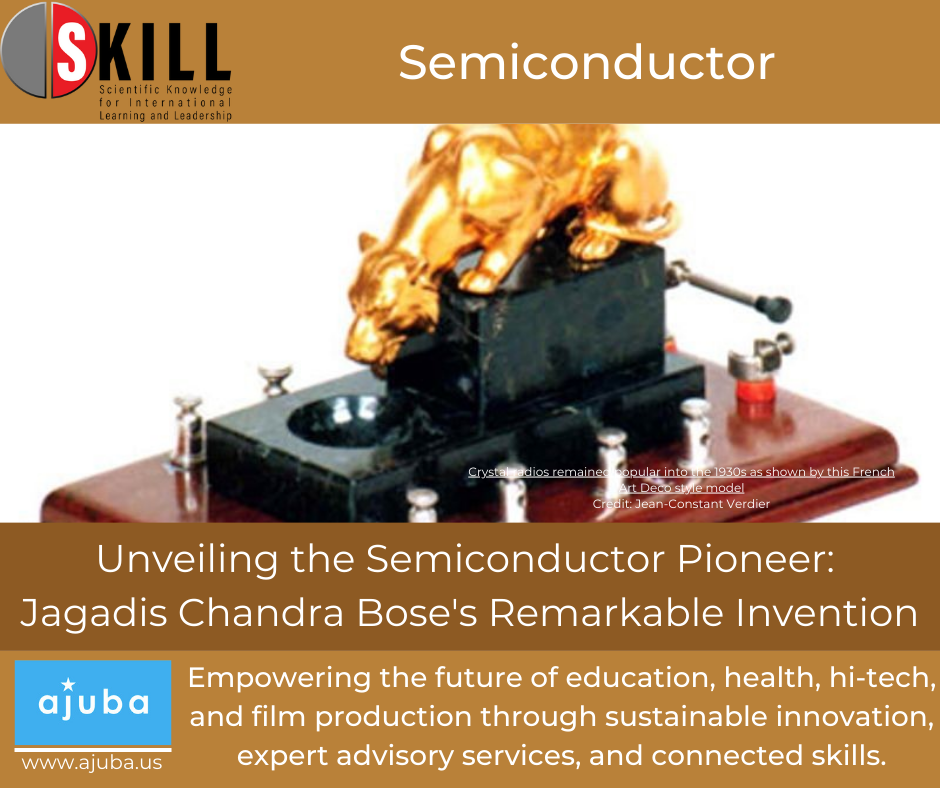Volume 6 | Did You Know?
Jagadis Chandra Bose Was the Pioneer in Semiconductor!
When we think of groundbreaking advancements in the field of semiconductors, names like Bell Labs, Fairchild, and Intel come to mind. However, it might come as a surprise that long before these industry giants emerged, a remarkable pioneer from India, Jagadis Chandra Bose, had already made significant strides in semiconductor technology. In 1901, Bose patented the use of a semiconductor crystal rectifier, popularly known as “cat’s whisker” detectors, to detect radio waves. This early innovation paved the way for the future dominance of the semiconductor industry. Let’s delve into the story of this unsung hero and explore the importance of understanding history to shape the success of an industry.
On June 15, 2023, I was on the JUS TV Hindi Show – “Straight Talk” to provide my views on the History of Semiconductors and Ecosystem Elements to make it a success in India. Watch the video on the link below:
Introduction:
Unveiling the Trailblazer:
Jagadis Chandra Bose, a multi-talented scientist, made significant contributions to various fields, including physics, biology, and engineering. His groundbreaking work in the area of semiconductor rectifiers revolutionized the way radio waves were detected and laid the foundation for future developments in the semiconductor industry. Patenting his invention in 1901, Bose’s use of semiconductor crystals marked a pivotal moment in the history of technology.
The Significance of Bose’s Invention:
Bose’s use of the “cat’s whisker” detectors was a groundbreaking concept at the time. These detectors were based on the property of certain semiconductor crystals to act as one-way valves for electric current, allowing the detection of radio waves. This invention not only enabled the detection of wireless signals but also established the fundamental principles of semiconductor electronics. Bose’s pioneering work preceded the rise of renowned institutions like Bell Labs and laid the groundwork for subsequent advancements in the field.
The Importance of Understanding History:
To build a successful industry in any region or country, it is essential to study the historical milestones and learn from the accomplishments of past innovators. Bose’s remarkable achievement reminds us that innovation knows no boundaries and can emerge from unexpected places. By delving into the history of the semiconductor industry, we gain insights into the early foundations and can identify opportunities for further growth and dominance in the market.
Shaping the Success of the Semiconductor Industry:
Studying the history of the semiconductor industry allows us to identify key players, technological breakthroughs, and the factors that contributed to their success. By analyzing the pioneers like Jagadis Chandra Bose, we can learn valuable lessons and apply them to shape the success of the industry in our region or country. Understanding the evolution of semiconductor technology, its applications, and the challenges faced by early inventors helps us build a strong foundation for future developments.
Embracing Innovation and Collaboration: Building a dominant position in the semiconductor industry requires a culture that fosters innovation, collaboration, and continuous learning. By acknowledging the contributions of trailblazers like Bose and creating an environment that encourages research, development, and knowledge sharing, we can nurture the growth of the industry in our region. This entails fostering partnerships between academia, industry, and government, providing support for research and development initiatives, and promoting entrepreneurship and startup ecosystems.
Conclusion:
The story of Jagadis Chandra Bose’s pioneering work in semiconductor rectifiers serves as a testament to the importance of understanding history in shaping the success of an industry. By recognizing the accomplishments of early innovators and learning from their achievements, we can chart a path towards dominance in the semiconductor industry. Let us embrace innovation, collaboration, and a deep appreciation for our technological heritage as we propel the future of semiconductor technology in our region or country.
About Baljit Singh:
Baljit Singh is an accomplished professional with over 30 years of expertise in semiconductor equipment and process management. With a degree in Microelectronic Engineering and a track record of delivering innovative products and services to the market, Baljit brings a wealth of knowledge and experience to semiconductor manufacturing projects. Baljit is currently, CEO of Ajuba, Chairman of Roar 4 Change and Founding Member of Guru Nanak Dev Global University. With his extensive experience and expertise, Baljit has made significant contributions to various projects and industries, revolutionizing printer technology, automotive safety, defect classification systems, and solar energy. Additionally, his involvement in non-profit activities showcases his dedication to helping others and making a positive impact in the community.
